We had a reader request for “classic American dishes.” We decided to start with French fries.
Ingredients
The ingredients are simple:
- We made three flavors using russet potatoes, Asian sweet potatoes, and American sweet potatoes.
- For oil we used the Beef Tallow that we showed how to make last week.
Preparation
Start by cutting uncooked potatoes or sweet potatoes into appropriate shapes. We favor finger-sized slices or thin chips, and keeping the skin on. Here are russet potatoes, Asian sweet potatoes, and American sweet potatoes:
After slicing, soak them in a bowl of water as shown above. The purpose of this is to draw out starch. You can rub the potato with your fingers: it will feel slimy as long as there is starch there. You may need to rinse the potatoes 3-4 times to remove the starch. When you’re done, the slimy feel should be gone and the water should be clear.
Removing the starch will make the French fries crispy.
After the starch is removed, lay the fries out to dry:
It is important that they dry thoroughly. There must be no water when they are cooked. Drying takes at least 30 minutes.
Frying the potatoes occurs in two parts: once to cook the potatoes through, and a second time to make them crispy.
Put beef tallow (or whatever oil you are using) into a saucepan to a depth of a few inches, and heat it to a middling temperature about 275 F / 135 C. Add as many dried potato slices as will fit in the oil:
It doesn’t take long to cook: about 3 to 5 minutes. When they’re done, remove the fries; we used chopsticks.
At this stage the fries will look like this:
Set the fries aside for at least 10 minutes — 30 minutes is safer — to let them cool. They should be comfortable to the touch. If you want to freeze fries for future use, this would be a good stage to put them in the freezer.
But if you’re finishing the fries now, heat the oil to a high temperature — more like 350 F / 175 C, which is almost to the smoke point of most cooking oils — and return the cooled fries to the oil. Leave them in for just 2 to 3 minutes and remove. This will make the fries crispy, looking like this:
Sprinkle salt and any other spices you like on them, and they’re done!
Conclusion
French fries are really easy, if a bit time consuming, to make, and really hard to stop eating.
Our potatoes and Japanese sweet potatoes were superb, but the American sweet potato discs were only good — a little soft. Perhaps this species has extra water, or perhaps the disc shape needs more cooking time than we gave it.
We use our beef tallow for at most 3 batches — that is, 3 rounds at the low temperature and again at the high temperature — and then discard it. Because beef tallow solidifies at room temperature and can clog pipes, don’t pour it down a kitchen drain; let it solidify and discard it as solid trash in an appropriate container.
French fries have a tremendous taste to expense ratio — especially if you’ve been able to get beef fat for free from your butcher, like Paolo! Highly recommended.







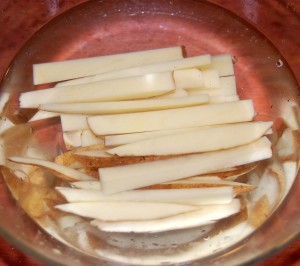
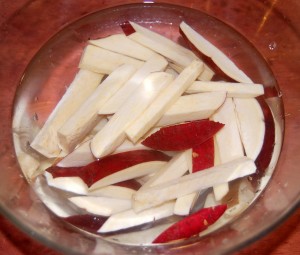
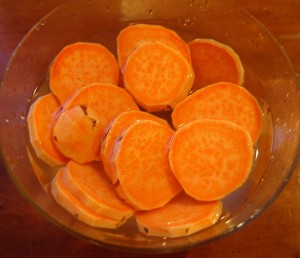
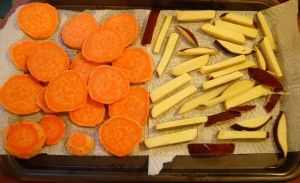


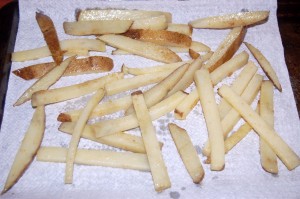
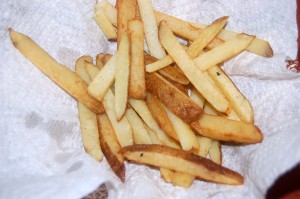





Mmm! I made french fries exactly like this 2 weeks ago and they were delicous.
I ran some malanga, boniatillos, and yuca through the food processor to make very thin discs and then soaked and fried them as described above. My four year daughter loved them!
We fry potatoes in coconut oil and this is also delicious.
I pan fry them in a 50/50 mix of coconut oil and ghee. I’ve never soaked them before and they always come out very crispy for us. We’ve been doing more sweet potato recently and usually cut them in half moon shapes (like your discs, but then cut in half again). Also, I usually don’t deep fry them. We’ve found they get golden crispy around the edges and very nicely cooked if you just put about 1/8 inch if oil in the bottom of the pan so that the potatoes are basically just ‘sitting’ in the oil, then we flip em all after about 7-8 minutes and do the other side for a few minutes.
Anyway I guess there would be several different methods.
Thanks for this write-up!
So now the question is: How healthy is it?
Should we worry about preservatives that are on the skin of the potatoes? What happens metabolically when you eat starch that’s embedded in fat? Can you eat it every day without worries?
If a healthy person doesn’t have to worry about the glycemic response of boiled potatoes, I suppose french fries are fine or better? What about compounds that get created at high temperatures?
I still eat french fries since eating PHD-ish but only when they are really delicious and crispy, so not soggy or with pronounced fat overtones.
oh and here in Belgium we use one of these to get the fries out of the fat:
http://www.polaris.nl/bakbenodigdheden/q/page/profile_view/profile_id/3353/type/product
Chinese cuisine has these too, no?
Yes.
http://www.amazon.com/6-diameter-Bamboo-Skimmer-Strainer/dp/B00012F3U4
Alton Brown calls these spiders.
I feed the leftover beef tallow to the dog.
Soaking in water to draw out the starch will also draw out water-soluble nutrients like Potassium- do you think this classic recipe could be improved (from a health perspective) by skipping the soaking?
About prewashing the potatoes, I once did a comparison in which I thoroughly prewashed diced white potatoes, then fried them in a skillet. Compared with a batch that wasn’t washed, the washed fries had little taste. I was disappointed.
I concluded that a large part of the taste of fried potatoes comes from the surface starch combining with the hot fat to make a tasty crust.
Maybe it’s different for french fries, which I haven’t made.
Just thought I would mention that potatoes that are used for commercial chips and fries have a much higher sugar content than a normal baker from the grocery store (this is achieved during long term storage). This higher sugar level allows them to get much more crispy than you will be able to achieve at home, regardless of the oil used.
Thanks for the recipe, Paul.
Do you strain your oil between uses? Also, Alton Brown recommends adding only small amounts during deep frying because the sudden temperature change from the cooler items will drop the oil temp and could cause the cooked items to be greasier. Have you found this to be true?
Hi Paul,
Twice fried potatoes on the PHD? What are your thoughts about the toxicity of ingested acrylamide?
Curious.
Best, KKC
Thanks, all. Great comments and questions.
Some background – We don’t normally cook fried food, so this is new to us. We are learning because many people like these foods, especially kids, and so the cookbook should have these recipes. We test and refine the posted recipe, but we haven’t necessarily tried alternative methods.
In this case, we followed recipes that called for rinsing away starch. Perhaps that’s not necessary; we’ll try skipping that step and see how it turns out.
Hi John – Malanga, boniatillo, and yuca – I had to look the first two up, and am still confused because boniatillo seems to be a sweet potato pudding. But it sounds great!
Hi Jack, Greg, and Tom – Thanks for the tips. We’ll try skipping the rinse. Greg, potassium loss is a concern, and that’s one of the best nutrients in potatoes. Tom, if unrinsed potatoes really do taste better, that would be a double benefit. I can tell you ours tasted very, very good.
Hi Wout – I’m not sure what you mean by preservatives. Pesticides and other compounds can be removed by washing with hot water and soap or detergent. If you mean toxins like solanine and chaconine, these are low in commercial strains of potatoes if they have been kept from light and heat.
Starch and fat are a healthy combination, in fact they are part of most of our meals.
Thanks to you and erp for suggesting the straining tool. Looks like we’ll have to buy one!
Hi Matt – Lucky dog!
Hi Frosty – We don’t strain the oil if it’s continuously heated, but if it’s going to go back in the refrigerator before re-use then we do.
Thanks for the tip about the sugary potatoes and the temperature drop. It sounds plausible, but we didn’t have any trouble with temperature drops in these fries. Perhaps we weren’t filling the pot as much as a commercial chef would want to do. I think drying the potatoes well reduces the risk, since water has such a high heat capacity.
Hi KKC – Acrylamide does seem dangerous but it always gets to amounts, and it’s not clear French fries have dangerous amounts. I understand the issue is still open, at least Wikipedia seems to indicate so (http://en.wikipedia.org/wiki/Acrylamide). Acrylamide seems to be formed from reactions between proteins and starch, so maybe rinsing the potatoes to reduce starch reduces the risk. Levels seem to be significant only if the food is browned, indicating Maillard reactions, and as you can see we pull our potatoes out before they are browned. So I doubt it was a problem in ours.
In general we avoid browning foods, preferring to cook so that foods retain their native appearance. This is why we didn’t use a blowtorch on our Creme Brulee.
It’s basically a not so sweet sweet potato. Sometimes it’s called a Cuban sweet potato.
Sheesh. Why is everybody so freaked out about potassium loss from rinsing and acrylamide formation? It’s french fries! – not intended to be a staple, but perhaps something for a little fun and variety now and again. Certainly better that anything restaurant-bought. As far as temperature drop goes, I recommend a candy thermometer to ensure the oil temperature doesn’t go below 325 or so. The reason for greasy foods is that at too cool a temperature the potatoes (or whatever) aren’t able to generate enough outward pressure as steam, thus enabling the oil to penetrate into the food more easily. Don’t crowd the fryer and you’ll be alright.
Paul and Shou-Ching: I have a question regarding resistant starch which was mentioned in your book. It seems that you’re saying that starch which has been cooked and allowed to cool becomes a short-chain fat source, and as such could no longer be thought of as a carbohydrate. Furthermore, while I’m not convinced of the importance of glycemic index in determining a food’s propensity to cause a blood sugar rise, has it been determined that a resistant starch would be a low glycemic-index food because it’s not being digested into simple sugars via amylase? Thanks.
FYI…..the Greenheads will eat you for lunch at Plum Island this weekend. Might choose another location.
Hi Jeff,
Agreed, it’s French fries. Not the end of the world if they’re not as healthy as we’d like. Still, we’d like to do the best we can.
After cooking and then cooling, some starch does turn into fiber (“resistant starch”), and this type of fiber is probably the most healthful variety of fiber based on current evidence.
Resistant starch is indeed a zero-glycemic index food.
However, in any starchy food there will still be plenty of digestible starch remaining after it is cooled. Resistant starch will be a minority. So the food itself may continue to be a high GI food.
Hi Balticblue –
We were there 4 weeks ago, it was fine, and we haven’t had a problem in past summers either. Have you been there recently?
I liked the looks of John @ Hunter-Gatherer’s sweet potato chips: http://hunter-gatherer.com/blog/recipe-sweet-potato-chips
French fries ARE a staple in our house.
Heat the oil until it bubbles. While the oil is heating, we peel the potatoes using an apple peeler, then cuts them into fry shape. When the oil is bubbling, we put them in one potato at a time….no soaking or rinsing or cooking twice. We use coconut oil exclusively and reuse the oil, over and over and over and over. It does not need to be refrigerated or tossed unless you burn it…which is hard to do, unless you leave it heating unused for an hour or something.
Paul, I was actually referring to the practice of adding pesticides to potatoes post-harvest. I had a hard time finding documentation, but I found this paper which has the first page readable:
http://pubs.acs.org/doi/abs/10.1021/jf00050a044
Potatoes are also one of the foods listed as containing the most pesticides in the skin, for which I found no scientific backing: http://www.ewg.org/foodnews/summary/
Basically, if you’re unsure where your potatoes come from, peeling is probably best.
I’d also like to say that here in Belgium, fries are made exactly as you describe it but as far as I know we don’t soak the frenched potatoes. We do soak the potatoes after peeling but that’s just briefly, to wash away dirt I presume.
Fries were fried in beef tallow from the time Belgians invented them up until the 80s when people wanted to have vegetable oils instead. The best fries shops (http://en.wikipedia.org/wiki/Friterie) still use a beef tallow/palm oil mix. The claim is that the palm oil keeps the fries tasting “lighter”.
Another way I really like potatoes is pan-fried: First (skin and) boil potatoes, and store them in the fridge (builds resistant starch). Then when I want some, heat butter in a pan (I add thyme) and drop in slices of potato, about a pencil-width thick. Turn them over when they’re getting a nice color. I presume this way of cooking creates less acrylamide due to the lower temperatures although I have no idea how hot my pan gets.
Hmmm, potatoes… I’m going to have lunch now.
Thanks for the recipe Paul.
My daughter’s favorite fries are McDonald’s and chicken nuggets with BBQ sauce. I’m always hoping I can get her to prefer home cooked versions of foods. I think I’ll need to use my mandoline to get the fries nice and thin.
She teases me she should eat gummy worms (candy) for gelatin. She loves PHD ice cream which is wonderful during the summer!
Thanks,
Mark
Thanks for the reasoned response, Paul. I learned of the acrylamide issue when it was surrounded by hysteria. I already didn’t eat fries/fried things, this was just another reason for me to stay away. (‘Tho once upon a time. man did I love French fries – dipped in chocolate milkshake! And the pommes frites I’ve had in Belgium…)
A link from the Wiki article (citation 39) mentions both soaking in acidulated water and/or parboiling as ways the home cook might lessen the formation of acrylamide in their baked or fried foods.
@Jeff D,
This was Paul’s first entry about “Classic American dishes.” That didn’t read occasional treat to me.
Best to all, KKC
It’s not just pesticides that are sprayed onto potatoes when they are in storage. Anti-fungals and sprout inhibitors are also used. There is a lot of chemical used in potato storage. When you have over a million dollars worth of product sitting in a storage shed, you can’t afford to let rot get started in the pile.
It’s supposedly all safe, but I stopped eating potato skins when I started working in the potato industry.
Wout and Frosty, thanks, I didn’t know about the post-harvest treatments. I guess we’ll start peeling our potatoes.
Hi Frosty,
What about organic potatoes? And are all types of potatoes treated? Russet, red potatoes, etc?
I love roasted red potatoes, skin on. I would miss them!
Teri
I had a brain cramp the other day when I mentioned the sweeter potatoes for frying. Potatoes meant for frying are actually a balance of sugar and starch. Too much glucose can turn potatoes unacceptably dark when fried.
When potatoes are stored below 45°F, the starch converts to sugar, particularly glucose. This is why you don’t want to keep your spuds in the fridge.
Teri, sprout inhibiting with organic potatoes is mostly done by cold storage, though there is some experimenting going on with clove oil and/or hydrogen peroxide. I don’t know how they handle fungus and other pests. Maybe the cold storage handles that, too. Keep in mind that the organic may not fry well because of the higher sugar content from the cold storage.
Small potatoes like red and Yukon are not generally stored as long so they don’t have as much chemical applied.
All of this refers to potatoes in storage, so if they are fresh out of the field, it doesn’t apply. The vast majority of potatoes in the store have been stored for at least a little while because that is how you heal the potatoes from the harvesting damage (suberizing).
Made the french fries using this method last Sunday. It was a very long process, including rendering the beef tallow, used up a lot of pots and other utensils and required a lot of clean-up (splattered counters, tallow-coated pots and spatulas that had to be washed right away so they wouldn’t harden) and didn’t turn out quite as crispy as we’d hoped. They were tasty enough, though, but the kids weren’t too impressed. So, I guess we won’t be doing these too often in the future unless the kids develop a taste for french fries. I wondered if it would make more sense to do them in a deep fryer, but then thought cleaning hardened beef tallow from the basket would be a nightmare. It kinda makes sense that fast food chains offer french fries, since making them at home seems like such a hassle. Anyhow, the ends didn’t seem to justify the means in our case.
I’m just as happy roasting fingerling taters (in ghee) and then tossing them in an awesome parsley and garlic persillade pesto when they’re cool enough to touch. I make persillade in my food processor. Remove large stems from several bunches of parsley, wash and spin dry. Place in food processor. Add a clove of garlic for each bunch of parsley. Add salt, black pepper, and a teaspoon of olive oil for each bunch of parsley. Process until a pesto consistency achieved. Store in freezer if you don’t plan to use it in the next few days.
Maggie,Love that persillade pesto idea. Can’t wait to try it. I also am very happy with potatoes roasted in ghee and appreciate that they don’t make as much of a mess as frying. I have found that the Carola variety works best for roasting. Very close to a fry in texture with . I am not sure how available they would be to buy, but would recommend them if you garden
Here is another method. Slice potatoes into 1/4-1/3″ sections, keep them upright and separated and microwave till tender. Dry skins will form on the cut surfaces, which brown beautifully and don’t stick. Takes under 10″. Pan brown or roast potatoes in a little oil or fat, with sprigs of rosemary, thyme, salt and pepper. Delicious and fast. I use boilers (waxy) rather than chippers (the typical mealy french friers), because they are higher protein/lower starch, and taste great. Home grown is best! Early potatoes take 60 days from planting to harvest, and can store in the ground for months; dig as needed.
We use a techniques that was in Cooks Illustrated to make french-fry-like potatoes. It doesn’t work as well with other roots/tubers, perhaps because they are lower in starch (?) Perhaps other tubers, roots etc. could be improved with experimentation. Basically: Preheat a baking sheet in the oven at 450 deg, slice potatoes into 1/4″ diam. rounds, par-boil for 5 min, remove to a mixing bowl, add some oil (melted tallow) and salt and stir vigorously until the potatoes develop a glue like coating (Cooks Illustrated says this is the starch being drawn out), pull out the baking sheet throw down a little oil (tallow) and spread out the potato rounds, bake foe a few minutes then flip ’em. The gluey starch coating on the potatoes becomes crisp as lightly browns while the insides come out very moist. In my opinion these are better than any french fries I’ve had and though there are 2 cooking steps, I still feel like its far less work than deep frying. We haven’t actually tried tallow, but works well with coconut oil. I’ve tried beets, yams, sweet potatoes, rutabaga, and probably a few other things this way and they are good, but not nearly as crispy on the outside. I’m wondering if I could add some potato starch to the mixing bowl step to create a crunchy starch coating on other veggies? Hmmm……
Love your site, keep up the good work. Excited to hear that you have a cookbook in the works.
Thanks Eli! Agree, I hate deep frying. Cool idea with the potato starch – heading toward tempura!
How many carbs do 100 grams of white potato or asian sweet potato without skin have? Every nutrition data bank says something different…
These local cassava (or tapioca) flours are not well suited for use in baking applications which are based on wheat flour in the rest of the world, including North America.
Paul, for a quicker recipe do you approve microwave-use?
I’ve found I can make great sweet potato home fries (the little chunks that you might get with eggs for breakfast).
After dicing the potato (which I find easier than getting the proper length spears), I microwave the lot for 4-5min, while heating some coconut oil. I believe some of the starch also comes out during this process. Then, throw them in the pan and add whatever spices you’d like! That way the insides are cooked and slightly mushy, but allows for a slightly crispier outside. Make ’em ALL the time.
Paul has said before that microwaves are OK.
A remember back a half century watching fresh French Fries being prepared at a local McDonalds. When the chain was very small and the Hindues and Keyesnians and Center for Science for the Public, yada yada hadn’t poisoned us.
The deskinned potatoes were put in French Fry press…I’m sure you can still find them…the lever pulled down, voila. They then soaked for some time in a vat to remove some of the starches and soluables.
Then, into the beef tallow! I can’t cite anything, but I remember my own research that indicated Micky D’s used tallow, or mostly tallow, until the aforementioned conspirators came along.
The fattest kids of my era would now be looked at as pudgy normal.